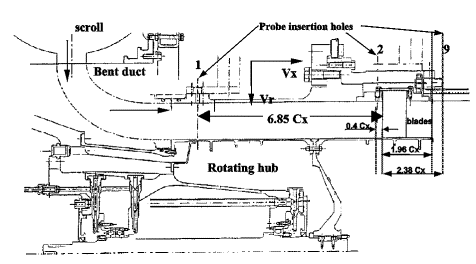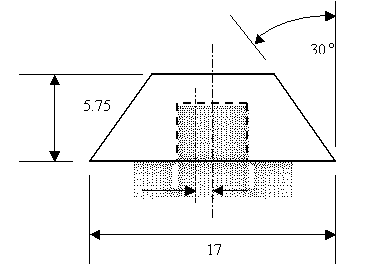Best Practice Advice AC1-01: Difference between revisions
No edit summary |
m (Dave.Ellacott moved page Silver:Best Practice Advice AC1-01 to Best Practice Advice AC1-01 over redirect) |
||
| (8 intermediate revisions by 3 users not shown) | |||
| Line 1: | Line 1: | ||
{{AC|front=AC 1-01|description=Description_AC1-01|testdata=Test Data_AC1-01|cfdsimulations=CFD Simulations_AC1-01|evaluation=Evaluation_AC1-01|qualityreview=Quality Review_AC1-01|bestpractice=Best Practice Advice_AC1-01|relatedUFRs=Related UFRs_AC1-01}} | |||
='''Aero-acoustic cavity'''= | ='''Aero-acoustic cavity'''= | ||
| Line 8: | Line 10: | ||
'''Key Fluid Physics''' | '''Key Fluid Physics''' | ||
[[Image:d34_image002.gif]] | [[Image:d34_image002.gif]] | ||
Description of Application Challenge | Description of Application Challenge | ||
[[Image:d34_image004.gif]] | |||
(Figure dimensions in inches) | |||
• M219 Transonic Cavity | |||
• M∞ = 0.85 | |||
• L/D (length/depth ratio) = 5 | |||
• W/D (width/depth ratio) = 1 | |||
• ReL = 6.84x106 | |||
[[DOAPs]] | |||
DOAPs | |||
On 10 points along cavity ceiling; | On 10 points along cavity ceiling; | ||
| Line 41: | Line 49: | ||
• Power Spectral Density (PSD) or Sound Pressure Level (SPL) | • Power Spectral Density (PSD) or Sound Pressure Level (SPL) | ||
Flow Physics | |||
'''Flow Physics''' | |||
• Sharp edge separation | • Sharp edge separation | ||
| Line 47: | Line 56: | ||
• Cavity flow recirculation | • Cavity flow recirculation | ||
• Shear layer oscillation. The DOAPs are driven by the shear layer oscillation, therefore it is important to resolve this feature well. | • Shear layer oscillation. The [[DOAPs]] are driven by the shear layer oscillation, therefore it is important to resolve this feature well. | ||
• Large eddy structures | • Large eddy structures | ||
| Line 53: | Line 62: | ||
• Coherent (vortex shedding) and broadband (turbulent) structures | • Coherent (vortex shedding) and broadband (turbulent) structures | ||
Underlying Flow Regimes | |||
'''Underlying Flow Regimes''' | |||
• Cavity Flow | • Cavity Flow | ||
| Line 60: | Line 70: | ||
Neither of these are in the Knowledge Base. | Neither of these are in the Knowledge Base. | ||
Application Uncertainties | |||
'''Application Uncertainties''' | |||
• Upstream turbulence level | • Upstream turbulence level | ||
• Boundary layer ahead of cavity leading edge – not known whether the boundary layer is tripped or not. | • Boundary layer ahead of cavity leading edge – not known whether the boundary layer is tripped or not. | ||
Computational Domain | '''Computational Domain and Boundary Conditions''' | ||
'''Computational Domain''' | |||
• Upstream domain starts at rig sharp leading edge, downstream one cavity length behind cavity trailing edge. | • Upstream domain starts at rig sharp leading edge, downstream one cavity length behind cavity trailing edge. | ||
| Line 75: | Line 87: | ||
• Side domains one cavity width away from side edge. | • Side domains one cavity width away from side edge. | ||
Boundary Conditions | |||
'''Boundary Conditions''' | |||
• M=0.85, T=305.06K on upstream boundary | • M=0.85, T=305.06K on upstream boundary | ||
| Line 82: | Line 95: | ||
• No slip conditions on cavity walls, with hybrid low-Re / wall-function | • No slip conditions on cavity walls, with hybrid low-Re / wall-function | ||
Discretisation and Grid Resolution | |||
'''Discretisation and Grid Resolution''' | |||
• Second-order special discretisation (MARS) on momentum | • Second-order special discretisation (MARS) on momentum | ||
| Line 90: | Line 105: | ||
• Better than 1st order temporal discretsation | • Better than 1st order temporal discretsation | ||
Physical Modelling | |||
'''Physical Modelling''' | |||
• Transient | • Transient | ||
| Line 98: | Line 115: | ||
• Low-Reynolds number k-epsilon (linear and non-liners) turbulence models | • Low-Reynolds number k-epsilon (linear and non-liners) turbulence models | ||
Recommendations for Future Work | |||
'''Recommendations for Future Work''' | |||
• Extension to 3D | • Extension to 3D | ||
| Line 108: | Line 127: | ||
Both these recommendations have been followed in later studies reported by the Application Challenge Author – see additional reference section below [1,3]. | Both these recommendations have been followed in later studies reported by the Application Challenge Author – see additional reference section below [1,3]. | ||
Additional References | |||
'''Additional References''' | |||
[1] Mendonca, F., Allen, R., de Charentenay, J. and Kirkham, D., “CFD Prediction of narrowband and broadband cavity acoustics at M=0.85”, AIAA-2003-3303, 9th AIAA/CEAS Aeroacoustics Conference and Exhibit, Hilton Head, South Carolina, USA, May 2003. | [1] Mendonca, F., Allen, R., de Charentenay, J. and Kirkham, D., “CFD Prediction of narrowband and broadband cavity acoustics at M=0.85”, AIAA-2003-3303, 9th AIAA/CEAS Aeroacoustics Conference and Exhibit, Hilton Head, South Carolina, USA, May 2003. | ||
| Line 116: | Line 136: | ||
[3] Allen, R., and Mendonça, F., “DES Validations of Cavity Acoustics over the subsonic to Supersonic Range”, AIAA-2004-2862, 10th AIAA/CEAS Aeroacoustics Conference and Exhibit, Manchester, UK, May 2004 | [3] Allen, R., and Mendonça, F., “DES Validations of Cavity Acoustics over the subsonic to Supersonic Range”, AIAA-2004-2862, 10th AIAA/CEAS Aeroacoustics Conference and Exhibit, Manchester, UK, May 2004 | ||
© copyright ERCOFTAC 2004 | © copyright ERCOFTAC 2004 | ||
---- | |||
Contributors: Fred Mendonca; Richard Allen - Computational Dynamics Ltd | Contributors: Fred Mendonca; Richard Allen - Computational Dynamics Ltd | ||
Site Design and Implementation: Atkins and UniS | Site Design and Implementation: [[Atkins]] and [[UniS]] | ||
{{AC|front=AC 1-01|description=Description_AC1-01|testdata=Test Data_AC1-01|cfdsimulations=CFD Simulations_AC1-01|evaluation=Evaluation_AC1-01|qualityreview=Quality Review_AC1-01|bestpractice=Best Practice Advice_AC1-01|relatedUFRs=Related UFRs_AC1-01}} | |||
Latest revision as of 14:42, 11 February 2017
Aero-acoustic cavity
Application Challenge 1-01 © copyright ERCOFTAC 2004
Best Practice Advice for the AC
Key Fluid Physics
Description of Application Challenge
(Figure dimensions in inches)
• M219 Transonic Cavity
• M∞ = 0.85
• L/D (length/depth ratio) = 5
• W/D (width/depth ratio) = 1
• ReL = 6.84x106
On 10 points along cavity ceiling;
• RMS pressures
• Power Spectral Density (PSD) or Sound Pressure Level (SPL)
Flow Physics
• Sharp edge separation
• Cavity flow recirculation
• Shear layer oscillation. The DOAPs are driven by the shear layer oscillation, therefore it is important to resolve this feature well.
• Large eddy structures
• Coherent (vortex shedding) and broadband (turbulent) structures
Underlying Flow Regimes
• Cavity Flow
• 2D Unsteady Shear Layer
Neither of these are in the Knowledge Base.
Application Uncertainties
• Upstream turbulence level
• Boundary layer ahead of cavity leading edge – not known whether the boundary layer is tripped or not.
Computational Domain and Boundary Conditions
Computational Domain
• Upstream domain starts at rig sharp leading edge, downstream one cavity length behind cavity trailing edge.
• Side domains one cavity width away from side edge.
Boundary Conditions
• M=0.85, T=305.06K on upstream boundary
• Side boundaries, top boundary and downstream boundary, constant pressure = 62059.14Pa
• No slip conditions on cavity walls, with hybrid low-Re / wall-function
Discretisation and Grid Resolution
• Second-order special discretisation (MARS) on momentum
• Hexahedral orthogonal meshes with successive 2x2 refinement into the shear layer and walls are necessary. Mesh dependency analysis shows low sensitivity to refiments greater than 40000 cells in the 2D plane.
• Better than 1st order temporal discretsation
Physical Modelling
• Transient
• Compressible ideal gas
• Low-Reynolds number k-epsilon (linear and non-liners) turbulence models
Recommendations for Future Work
• Extension to 3D
• LES-based turbulence modeling
• Full second-order central differencing special discretisation in the LES flow regions
Both these recommendations have been followed in later studies reported by the Application Challenge Author – see additional reference section below [1,3].
Additional References
[1] Mendonca, F., Allen, R., de Charentenay, J. and Kirkham, D., “CFD Prediction of narrowband and broadband cavity acoustics at M=0.85”, AIAA-2003-3303, 9th AIAA/CEAS Aeroacoustics Conference and Exhibit, Hilton Head, South Carolina, USA, May 2003.
[2] Allen, R., and Mendonça, F., “DES Predictions on the M219 cavity at M=0.85”, Colloquium EUROMECH 449, Chamonix, France, 7-8th December 2003
[3] Allen, R., and Mendonça, F., “DES Validations of Cavity Acoustics over the subsonic to Supersonic Range”, AIAA-2004-2862, 10th AIAA/CEAS Aeroacoustics Conference and Exhibit, Manchester, UK, May 2004
© copyright ERCOFTAC 2004
Contributors: Fred Mendonca; Richard Allen - Computational Dynamics Ltd
Site Design and Implementation: Atkins and UniS

